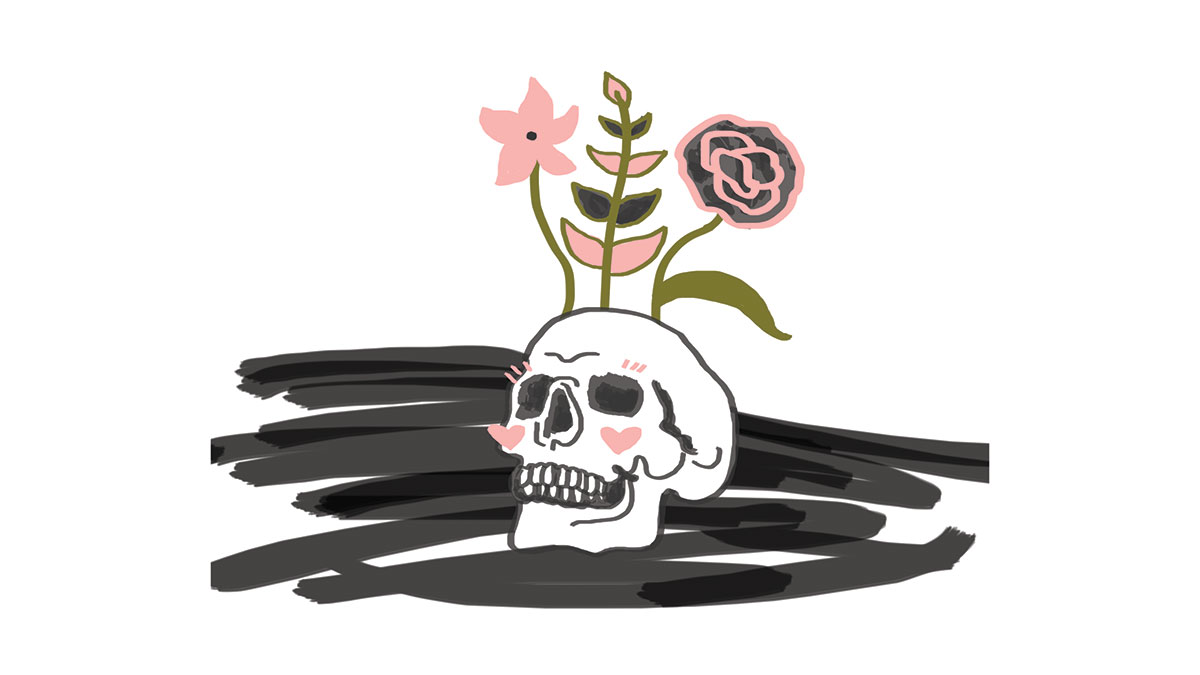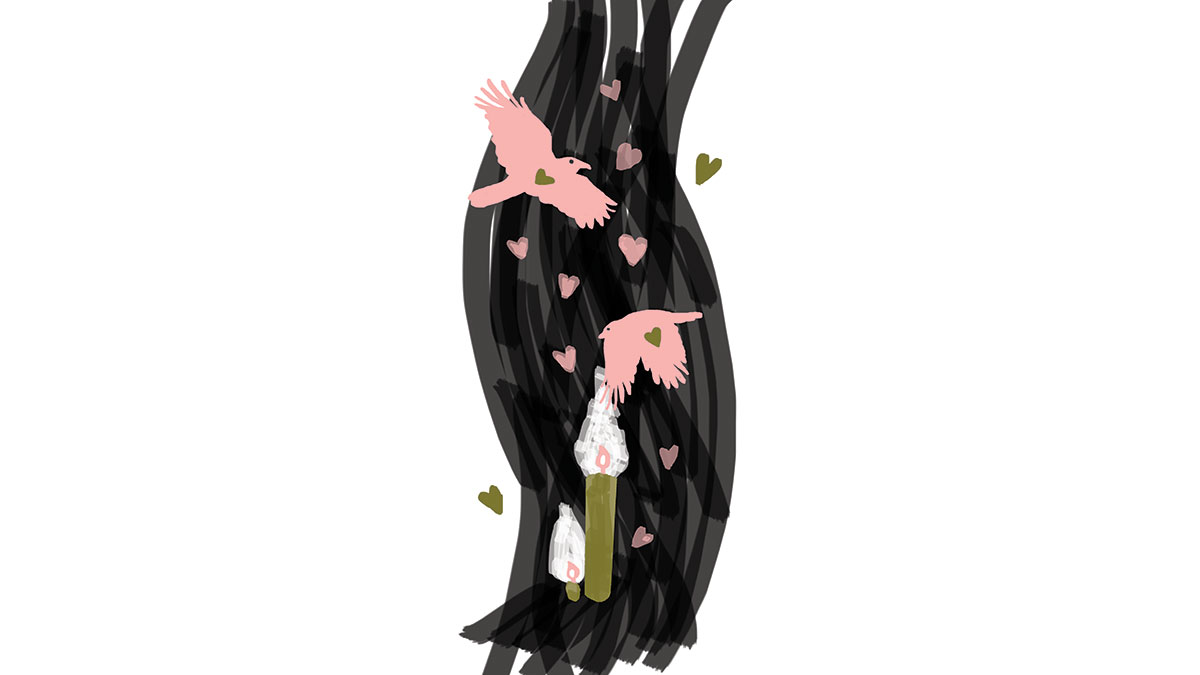Feature: The inevitable cessation of existence
 Alex Patterson
Alex PattersonThe level of hilarity in Spike TV’s 1000 Ways to Die is accompanied by a sense of guilt and underlying fear. The show’s darkly humorous narrator recounts true stories of bizarre deaths that are later explained by expert professionals. There’s a special, and somewhat guilty, amusement that comes with hearing a doctor explain how exactly the woman on TV died from masturbating with a carrot.
Those feelings of fear and humor are actually indicative the Western relationship people have with death.
That fear and fascination can be seen here on campus. Evaluations score relatively high for the Sociology of Death and Dying, one of the courses Professor Herbert Northcott has taught in his 40 years at the University of Alberta. It appears students enjoy discussing the inevitable cessation of existence.
“And you wouldn’t expect it, would you?” he says. “Suddenly I teach Death and Dying and I’m a better professor. That, or more likely, the students just like the course more.”
The 400-level course goes over topics of grief, the process of dying, and specific issues such as suicide and euthanasia — it even includes a field trip to a funeral home. But it also carries the bigger mission of making students think critically about a topic that is standard to see as negative.
The fear of death, the source of the negativity, is mechanical rather than existential, says Northcott. The scariest part about death is the thought of spending one’s last moments alone with no friends or family. Or in agony after being, say, run over by a dump truck. Ceasing to exist isn’t anywhere near as fearful.
Death is a social construct, Northcott says. Fear and fascination make up the body of the West’s rendition of death. The fear component grows from a “death-denying” attitude in Western culture, arising from the twentieth century — the Black Death, Spanish influenza, and tuberculosis all faded into stories as medical technology became mainstream. But as the number of infant graves declined so did the West’s relationship with death. Fascination follows fear, which is perhaps what makes the Sociology of Death and Dying so interesting to students.
That fear of pain, gore and suffering is what allows death to be funny. Laughter puts a safe distance between the individual and the idea of death, Northcott says. That’s exactly what he sees while teaching the course in death and dying. One minute, everyone’s crying. Next, they’re laughing to the point of crying.
People want to push the tragedy of death away, and one of the common ways to do this is through comedy. Which is something young people can do, Northcott said.
About 10 years ago, a twenty-six year old in Southern Manitoba had the misfortune of hitting a patch of black ice in the night. Neither he nor his dog in the passenger seat were belted in, so when the truck rolled eight times they both lost their lives. It was the night before Christmas Eve when my family, two provinces over, heard the news. The fatality had been Chris, my half-brother.
My mom ran downstairs, weeping, to tell 10-year-old me the news.
“Your brother crashed his car,” Mom said, sniffling. “He passed away.”
I immediately thought of my younger brother, aged eight. Where on earth did he get a truck? I was pretty sure he was in his room playing with Lego. I thought this was some kind of twisted joke, so I laughed.
My mom was horrified.
Nope, definitely not a joke. The next day was spent driving to Manitoba to make the funeral on Boxing Day. Chris was the real holiday spirit that year.
Writing Death
 Northcott was born in Brandon, Manitoba and grew up in Winnipeg. He made his academic start at the University of Manitoba, where he received his BA. He moved on to the United States to further pursue Sociology, earning his Master’s from Brigham Young University and his Doctorate from the University of Minnesota. Returning to Canada, he started teaching Sociology of Health and Illness at the University of Alberta in 1976. He later took over the courses Sociology of Aging and Sociology of Death and Dying.
Northcott was born in Brandon, Manitoba and grew up in Winnipeg. He made his academic start at the University of Manitoba, where he received his BA. He moved on to the United States to further pursue Sociology, earning his Master’s from Brigham Young University and his Doctorate from the University of Minnesota. Returning to Canada, he started teaching Sociology of Health and Illness at the University of Alberta in 1976. He later took over the courses Sociology of Aging and Sociology of Death and Dying.
Over the past 40 years, Northcott has taught 11,000 students in over 250 courses. He’s also written the only book about death and dying in Canada.
Northcott describes himself as a monographer rather than a researcher. His Dying and Death in Canada is a synthesis of research, organized to show readers how Canadians respond to death through both statistical and personal accounts.
Compiling a mosaic of experiences from cemetery workers, firefighters, and first responders shows how the experience of death is universal, Northcott says. Going over these accounts has been a big part of his job in revising the upcoming third edition, which actually sticks out as one of his favourite parts. Alone, he’s able to just spread out the chapters before him and read how individuals have recorded their relationships with death.
Those firsthand accounts are what Northcott finds particularly interesting. The textbook itself has a great deal of these — there’s the story of the Nova Scotian miners become trapped underground and believe they are to die, but still maintain a socially appropriate distance from each other despite being so near the end. There’s the one about a woman with cancer who worries about her young children growing up without a mother. These true stories about death remind Northcott of the novels he loves to read.
“The sociologist is at the greatest disadvantage, because we don’t get to write like novelists, or journalists,” Northcott says. “We have to be very academic.”
The underlying theme Northcott’s found in his work is PTSD. It’s common, Northcott says, but the popular concern for PTSD is largely overblown. Really, he says, most people move on and find peace. The nice part about writing a textbook about death is deconstructing the typical Western negativity surrounding it.
My grandmother, after probably fifty years of addiction to alcohol and cigarettes, passed when I was in high school. About 10 people showed up to say their final goodbyes before she was lowered into the ground.
Compared to my half-brother’s tragic funeral, the number of people who cared was marginal. The atmosphere around Chris’ death was of shock and disbelief. My grandma’s was just numb, with an underlying sense of amazement: she never once had lung cancer despite all of her smoking. We were all very impressed.
Aging, The Greater Threat
Still, the fear of death seems to be surpassed by the fear of aging — a process that comes with losing form and function. Something that Northcott has been able to witness as both a human being and a professor. Years ago when Northcott started teaching a related class, Sociology of Aging, he felt too young for the position. The veteran of academia now feels that he’s too old.
“There I am, standing in front of the class with my white hair, and I’m sort of the other,” he says. “I have a vested interest in the argument, they would assume.”
Northcott says young adults don’t really see agism like they do other –isms. Not in a menacing way, but simply because they don’t ever have to experience it firsthand. Agism is one of the last forms of discrimination whose existence can still be debated, Northcott says.
Terms like “bed-blocker,” and its derivative, “job-blocker,” though agist, reflect the expectation for seniors to make way for youth, Northcott says. To a lot of youth, the aged have had their “turn” in the workforce and should step aside.
Baby boomers are seen this way in popular discourse, despite paying 70 per cent of the cost of university education, Northcott says.
“There’s this argument that (baby boomers are) already these leeches who are sucking the lifeblood out of the economy,” he says.
Despite having been a faculty member for many years, Northcott himself has felt that others are trying to push him out.
Fifteen years down the road, the baby boomer problem will likely be renamed as the “senior surge.” The dominant discourse with aging is apocalyptic, Northcott says. Agist rhetoric is generally accepted; it’s curious how some things are, almost arbitrarily, considered problematic while others aren’t, he says.
Discrimination makes the issues of a marginalized group seem inferior when they really aren’t. Just look at the usual tragedy of young death juxtaposed with the typical quiet passing of the elderly, Northcott says. Young people are comparatively unlikely to meet an early end. Suicide rates, for example, are lower in youth — female and male suicide rates both peak in the mid age, and males again around the retirement age, Northcott says. And while it is a tragic problem, numerically it is not the largest problem.
Other demographics are more likely to commit suicide. Older individuals suffer more losses in family and friend circles and become victims of agism — that kind of sorrow puts one at higher risk.
Yet the greatest shock and sorrow regarding suicide tends to come from the lower-risk, higher-publicized demographic.
I went into a massive depressive episode last Christmas break. Bipolarism does that. It doesn’t happen often, but when it does, it’s bad.
In that time, I made an attempt on my own life by running a tube between my vehicle’s exhaust and window. (My family has awful luck when it comes to cars and the holiday season.)
It didn’t feel tragic, or life-changing. It was more of an unfortunate reality. The actual crisis moment itself was so distant from the numbness felt in the weeks leading up to it. It’s really hard to remember, just a blur.
The main message I’d get from family and close friends was always “go see a professional.”
Fine. But the clinical option felt really forced. The actual people I knew told me they weren’t qualified to help, so I was kept at arm’s length.
“Don’t tell anyone.” “Make sure you go see someone about it.” “I don’t know, you’re stressing me out. There’s a person you can talk to about this.”
It’s great to see clinical services becoming a more acceptable option —- so long as they’re not the option.
Silence on Campus
 People have a hard time discussing the tough topics: death, suicide, mental health. This is true for student life and for in-class discussion.
People have a hard time discussing the tough topics: death, suicide, mental health. This is true for student life and for in-class discussion.
Though the university demographic is supposed to be the source of dynamic discussion surrounding tough topics, the words, “Don’t be afraid to reach out for help,” are repeated without much further commentary.
In class, Northcott says it’s been increasingly difficult to get tough discussions underway. The contemporary student culture seems to accept that others have different opinions, but these opinions are to remain internal. The attitude of reciting the one “accepted” view on a subject is now dominating.
Thirty years ago the pros and cons of controversial topics were easily brought up, Northcott says.
“You’d walk into class and say, ‘let’s talk about assisted suicide … Let’s get the Baptist, and the business student, and the redneck talking,’” he says.
It had worked. People were willing to exchange their ideas, even if they bitterly clashed with each other. Today, it’s almost impossible to get that kind of interaction; instead, most of those with controversial opinions stay silent. What’s frustrating about teaching in such an environment is having to retreat back into the PowerPoints, Northcott says. The increase in classroom passivity is the biggest change he’s seen on campus in the past 40 years.
There isn’t one particular word Northcott uses to describe the current class atmosphere, but he does say there’s a feeling of fear. There risk for a student to voice a controversial opinion is too great, so most of them will likely choose to stay silent, he says. The self-defence move takes away from the classroom’s efficiency as a learning tool and the skills students exit with, Northcott says.
“The reason you take these classes is so that you develop a critical faculty, so you can explore these topics more critically,” Northcott says. “When students leave here, they leave here with a diversity of opinions. And that’s a good thing. But my concern is that people leave here with a diversity of opinions, but haven’t really gotten to the critical thinking level.”
Nevertheless, the fun of teaching Sociology of Death and Dying comes from deliberating questions that are much easier to pose than answer, Northcott says. From there comes the exciting and interesting discussion. Despite in-class silences, Northcott loves to educate.
“Each class is a conversation,” he says. “And it’s different every time.”
Sociology of Death and Dying will be taught again in the Winter semester, but this year it won’t be by Northcott. Even so, he did write the textbook. The course theme invokes hours of talking, but he says the general theme is the idea that things will turn out okay.
“As we get older, as we age, as we approach our deaths. Hopefully, it will all be, for the better. That’s the existential theme,” he says.





Great feature, but sentences are missing words. Kinda detracts from the article. C’mon Gateway, proofread please.
there’s the story of the Nova Scotian miners (,who?) become trapped underground and believe they are to die
It’s great to see clinical services becoming a more acceptable option —- so long as they’re not the (only?) option.